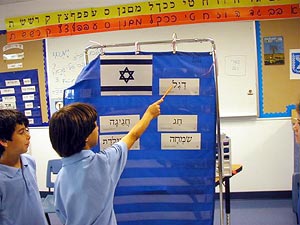- Home
- Play & Learn Home
- Online Enrichment
- Experience Modern Israel
- Israel It's Complicated
- Jewish and Me
- Jewish Holidays Jewish Values
- Jewish Values in Genesis and Jewish Values in Exodus
- Min Ha’aretz
- Our Place in the Universe
- Simply Seder
- The Prophets: Speaking Out for Justice
- Making T'filah Meaningful
- Make, Create, Celebrate
- Yom Haatzmaut Resources
- Hebrew Apps
- About The OLC
- What is the OLC?
- Introduction
- Get Started
- Resources
- OLC Content
- Parent Materials
- See My OLC Classes
- Store
In the Classroom: Case Study
How Shalom Ivrit Works in Our Day School
By Dr. Lenore C. Kipper, RJE
Ways to use Shalom Ivrit to teach Judaism through Hebrew in a day school setting.
| Download Printable Version (PDF) |
Our school had a dilemma: Which books would fit the philosophy of our Hebrew program—teaching Judaism through Hebrew, Yahadut b'Ivrit. The answer was the recently published Shalom Ivrit—Welcome to Modern Hebrew.
 |
| Dr. Lenore C. Kipper RJE, Judaic Studies Director at Temple Beth Am Day School, Miami |
With this series, we are now able to build a lifelong vocabulary for Jewish life by teaching students about the holidays and Jewish values, in Hebrew. We can give students opportunities for reading practice and comprehension; we can offer a variety of the foundational language patterns that are essential to understanding and speaking Hebrew in the classroom environment; and we can activate oral language usage. Shalom Ivrit does this through interesting, vocabulary-controlled stories with short, clear sentences and easy syntax. We use it as our core curriculum, and supplement it with additional Hebrew holiday material.
Our second graders used Shalom Ivrit 1 this year. They enjoy the humor in the stories—such as Dina's many excuses for not going to school—and the imaginative animal characters, Bar and Malmalah, who bring the material to life. As educators, the teachers and I value the way each chapter builds on earlier material, reusing vocabulary and word patterns to reinforce learning.
The single-sentence English directions help our children master the material at this early age. We believe that using limited amounts of a child's native language for directions and instructions is an educational advantage at this age, and although our Hebrew program is not Ivrit b'Ivrit, teachers often give their own directions in Hebrew. Our teachers have also found the Teacher's Guide helpful in providing a sound structure, with step-by-step plans for each unit.
We employ the following techniques to engage students and promote success. We:
- Encourage students to role play by using the dialogs with puppets and props. We tape record students as a record of their achievement.
- Allow the students to complete the activity and puzzle pages independently thereby encouraging a sense of mastery. The built-in, user-friendly dictionary in each story helps students work independently and correctly.
- Have students create their own midrash t'munah pages for each holiday. Colorful, engaging illustrations in the text help students create their own illustrations and write a few descriptive sentences in Hebrew. We save these and make them into a collection that the students take home at the end of the year. We have students create bulletin board murals for each holiday, combining Hebrew sentences and art work.

- Play vocabulary games using the Word Cards and the Picture Cards from the Teacher's Guide. For example, students read aloud sentences composed of Word Cards and Picture Cards, inserting the correct Hebrew word for the Picture Cards.
- Show students the story of Creation in a Humash and in a Torah scroll when they learn about Creation in Chapter 8 ("Mah Bara Elohim?"). We have them find the Hebrew days of the week and learn the first line of the Torah in Hebrew.
- Play Shiru Shalom Ivrit—the music CD—as an aural presentation to complement the visual presentation of vocabulary. Students sing along with the Hebrew songs, using the same vocabulary they encounter in the textbook.
- Use the checkpoints for cumulative review. Shalom Ivrit 1 introduces a core of twenty common usage verbs in the present tense and a total of 162 vocabulary words. The checkpoints allow teachers to track student progress and to remediate when necessary, for example, by reviewing key milon words.
- Assign pages in the Prayer Companion for students to begin to understand and analyze the blessings and prayers they have been hearing and reciting until now.
- Involve parents in their child's Hebrew studies. For example, we invite parents to the classroom to learn about Kabbalat Shabbat when we teach Chapter Six ("Shabbat Shalom"). And we have them prepare an art project together in which they draw and label the seven days of Creation.
Next year we plan to use Shalom Ivrit 2, with its theme of Jewish values. I expect the same excited and positive reaction from students and teachers alike.


